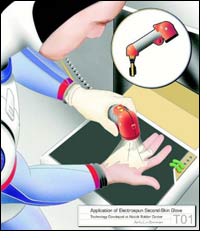Interviews
Nonwovens in space!!!
03 Jul '09
5 min read

This is one of the ideas from US researchers at the Massachusetts Institute of Technology (MIT) who are moving closer to a skin-tight and space-worthy astronaut garment called the BioSuit – envisaged as replacing the bulky traits of current, gas-pressurized versions with flexibility and mobility.
The researchers believe the key to such a second skin would be an organic, biodegradable spray-on layer.
This coating would protect an astronaut conducting a spacewalk in extremely dusty planetary environments. Electrically actuated artificial muscle fibres would be incorporated into that second skin to enhance human strength and stamina.
The Bio-Suit System could embody communications equipment, biosensors, computers, even climbing gear for spacewalks or what NASA calls an 'Extra Vehicular Activity' (EVA).
“When we get back to the Moon and on Mars, we're not going there to stay in a habitat,” said Dava Newman, professor in the Department of Aeronautics and Astronautics and Engineering Systems at MIT. “EVA becomes a primary function.”
Newman and colleague Jeffrey Hoffman, a former NASA astronaut and spacewalker, have been working with students and the design firm Trotti and Associates for a number of years to build a viable BioSuit.
A current prototype of the suit consistently exerts pressures of about 20 kilopascals on its wearer but newer models have reached pressures of up to 25 to 30 kilopascals – about one-third that of the Earth's atmosphere and the target for space-worthy BioSuit. A fully functional suit could be made ready for spaceflight in about ten years.
At the heart of the BioSuit is mechanical counter pressure, which uses tightly wrapped layers of material that are both flexible and protective to the astronaut inside. The suit's layers are wrapped in a meticulous fashion – based on three-dimensional maps of the human body in motion – to provide structural support while maintaining mobility.
“You can't do much bending of the arms or legs in the conventional type of suit,” said Ms Newman.
NASA's current Extravehicular Mobility Unit (EMU) spacesuits, as well as their Russian Orlan counterparts, surround astronauts in a stiff, pressurized vessel containing breathable air. Added outer layers of material, as well as a backpack-mounted life support system, can further restrict the spacesuit's mobility and require astronauts to spend the bulk of their energy fighting their own garments while toiling in space.
Both the EMU and Orlan spacesuits are designed for work in Earth orbit, not for use on planetary surfaces like those of the Moon or Mars, where walking – not floating – will be key.
“We really must design for greater mobility and enhanced human and robotic capability,” Newman said.
Newman hopes the BioSuits could be tailored to offer varying levels of resistance to their wearers for use as exercise garments for astronauts onlong flights to Mars, as well as athletes and those requiring aid to walk on Earth.
The researchers believe the key to such a second skin would be an organic, biodegradable spray-on layer.
This coating would protect an astronaut conducting a spacewalk in extremely dusty planetary environments. Electrically actuated artificial muscle fibres would be incorporated into that second skin to enhance human strength and stamina.
The Bio-Suit System could embody communications equipment, biosensors, computers, even climbing gear for spacewalks or what NASA calls an 'Extra Vehicular Activity' (EVA).
“When we get back to the Moon and on Mars, we're not going there to stay in a habitat,” said Dava Newman, professor in the Department of Aeronautics and Astronautics and Engineering Systems at MIT. “EVA becomes a primary function.”
Newman and colleague Jeffrey Hoffman, a former NASA astronaut and spacewalker, have been working with students and the design firm Trotti and Associates for a number of years to build a viable BioSuit.
A current prototype of the suit consistently exerts pressures of about 20 kilopascals on its wearer but newer models have reached pressures of up to 25 to 30 kilopascals – about one-third that of the Earth's atmosphere and the target for space-worthy BioSuit. A fully functional suit could be made ready for spaceflight in about ten years.
At the heart of the BioSuit is mechanical counter pressure, which uses tightly wrapped layers of material that are both flexible and protective to the astronaut inside. The suit's layers are wrapped in a meticulous fashion – based on three-dimensional maps of the human body in motion – to provide structural support while maintaining mobility.
“You can't do much bending of the arms or legs in the conventional type of suit,” said Ms Newman.
NASA's current Extravehicular Mobility Unit (EMU) spacesuits, as well as their Russian Orlan counterparts, surround astronauts in a stiff, pressurized vessel containing breathable air. Added outer layers of material, as well as a backpack-mounted life support system, can further restrict the spacesuit's mobility and require astronauts to spend the bulk of their energy fighting their own garments while toiling in space.
Both the EMU and Orlan spacesuits are designed for work in Earth orbit, not for use on planetary surfaces like those of the Moon or Mars, where walking – not floating – will be key.
“We really must design for greater mobility and enhanced human and robotic capability,” Newman said.
Newman hopes the BioSuits could be tailored to offer varying levels of resistance to their wearers for use as exercise garments for astronauts onlong flights to Mars, as well as athletes and those requiring aid to walk on Earth.
INDEX 11
Popular News
Leave your Comments
Dr. Michael Duetsch & Man Woo Lee
UPM Biochemicals and Dongsung Chemical
Therese Premler-Andersson
Textile Machinery Association of Sweden (TMAS)
































-Ltd..jpg?tr=w-120,h-60,c-at_max,cm-pad_resize,bg-ffffff)





.jpg?tr=w-120,h-60,c-at_max,cm-pad_resize,bg-ffffff)
.jpg?tr=w-120,h-60,c-at_max,cm-pad_resize,bg-ffffff)






